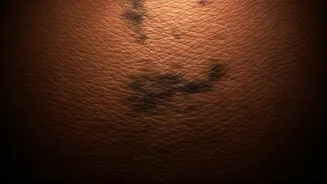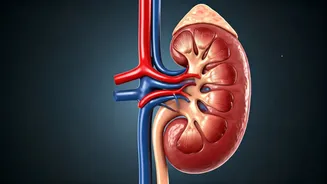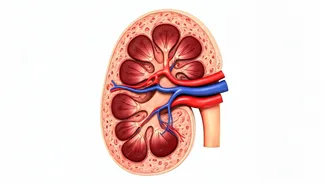What is AN?
Acanthosis nigricans (AN) is a skin condition characterized by areas of dark, thickened, and velvety skin. These patches often appear in body folds and creases,
such as the armpits, neck, groin, and elbows. The skin may also have a slightly raised or textured appearance. While AN is not contagious, it can be an indicator of an underlying medical condition, with insulin resistance and high blood sugar being the most common associations. The condition itself is relatively common, affecting people of all ages and ethnicities, though it's more prevalent in those who are overweight or have a family history of diabetes. The darkness of the skin can vary from a light tan to a dark brown or black shade, and the texture can range from smooth to rough. Recognizing these signs is crucial, as early detection can help in addressing the root cause, potentially preventing further health complications. Consulting a healthcare professional is always recommended if you notice these changes, as they can provide an accurate diagnosis and appropriate guidance.
Causes and Risks
The primary cause of acanthosis nigricans (AN) is often linked to insulin resistance, a condition where the body's cells don't respond properly to insulin, leading to elevated blood sugar levels. Insulin resistance frequently occurs in people with prediabetes or type 2 diabetes. Other factors contributing to AN include obesity, genetics, certain medications like corticosteroids, and, in rare instances, cancer. Insulin resistance triggers the overproduction of epidermal growth factor, which stimulates the rapid growth of skin cells, causing the dark, thickened patches. Individuals at higher risk include those with a family history of diabetes, those who are overweight or obese, and those with conditions like polycystic ovary syndrome (PCOS). Certain ethnic groups, such as those of African, Hispanic, and Native American descent, also tend to have a higher prevalence of AN. Regular health checkups and maintaining a healthy lifestyle, including a balanced diet and exercise, are crucial in managing and mitigating the risks associated with this condition.
Spotting the Signs
Identifying acanthosis nigricans (AN) typically involves recognizing the characteristic dark, velvety patches on the skin. These patches are most often found in areas where skin folds occur, such as the armpits, neck, groin, and the back of the knees. The texture of the affected skin is often thicker and can feel velvety or even rough to the touch. In some cases, the skin may also have a slightly raised appearance. The color of the patches can range from light tan to dark brown or black, varying depending on the individual's skin tone and the severity of the condition. Additionally, skin tags, small, benign growths, might be present along with the dark patches. When observing these changes, it's crucial to seek medical advice to confirm the diagnosis and rule out any underlying conditions. A dermatologist or healthcare professional can perform a visual examination and, if needed, may order blood tests to assess blood sugar levels and insulin resistance. Early detection can lead to timely intervention and improved health outcomes.
Blood Sugar Link
The strong association between acanthosis nigricans (AN) and blood sugar levels stems from insulin resistance. As insulin resistance increases, the body produces excess insulin to compensate for the cells' inability to use it effectively. This surplus of insulin can stimulate the growth of skin cells, leading to the dark, thickened patches associated with AN. High blood sugar levels often accompany insulin resistance, and both conditions are key markers of prediabetes and type 2 diabetes. The presence of AN can therefore serve as a visible warning sign of potential blood sugar imbalances, prompting individuals to seek medical evaluation. Testing blood sugar levels, including fasting glucose and HbA1c, is crucial for those with AN. Managing blood sugar through lifestyle changes, such as diet and exercise, and, if needed, medication can not only improve the appearance of AN but also mitigate the risk of developing diabetes and its complications. Regular monitoring and medical guidance are essential for effectively managing this condition.
Managing AN Effectively
Managing acanthosis nigricans (AN) involves addressing the underlying cause, which often includes lifestyle modifications and, in some cases, medical treatments. Weight loss, if you are overweight or obese, can significantly improve insulin sensitivity, thereby reducing the severity of AN. A balanced diet low in processed foods, sugary drinks, and refined carbohydrates, and high in fiber, fruits, and vegetables, is essential. Regular physical activity, such as brisk walking, swimming, or cycling, can also enhance insulin sensitivity. Medications like metformin may be prescribed to improve insulin resistance. Topical treatments, such as retinoids or exfoliating creams, can help lighten the affected skin areas. Consulting with a healthcare provider and a dermatologist is crucial for creating a comprehensive management plan. Regular monitoring of blood sugar levels and overall health is also important to track progress and make necessary adjustments to the treatment plan. Consistent adherence to these management strategies can lead to improved skin appearance and better overall health outcomes.













